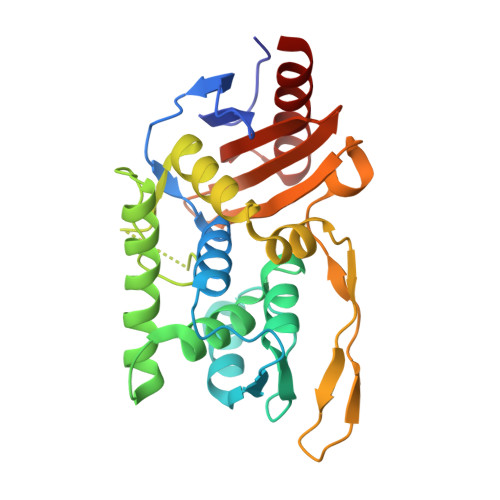Catalytic mechanism of the Streptomyces K15 DD-transpeptidase/penicillin-binding protein probed by site-directed mutagenesis and structural analysis.
Rhazi, N., Charlier, P., Dehareng, D., Engher, D., Vermeire, M., Frere, J.M., Nguyen-Disteche, M., Fonze, E.(2003) Biochemistry 42: 2895-2906
- PubMed: 12627955
- DOI: https://doi.org/10.1021/bi027256x
- Primary Citation of Related Structures:
1ES2, 1ES3, 1ES4, 1J9M - PubMed Abstract:
The Streptomyces K15 penicillin-binding DD-transpeptidase is presumed to be involved in peptide cross-linking during bacterial cell wall peptidoglycan assembly. To gain insight into the catalytic mechanism, the roles of residues Lys38, Ser96, and Cys98, belonging to the structural elements defining the active site cleft, have been investigated by site-directed mutagenesis, biochemical studies, and X-ray diffraction analysis. The Lys38His and Ser96Ala mutations almost completely abolished the penicillin binding and severely impaired the transpeptidase activities while the geometry of the active site was essentially the same as in the wild-type enzyme. It is proposed that Lys38 acts as the catalytic base that abstracts a proton from the active serine Ser35 during nucleophilic attack and that Ser96 is a key intermediate in the proton transfer from the Ogamma of Ser35 to the substrate leaving group nitrogen. The role of these two residues should be conserved among penicillin-binding proteins containing the Ser-Xaa-Asn/Cys sequence in motif 2. Conversion of Cys98 into Asn decreased the transpeptidase activity and increased hydrolysis of the thiolester substrate and the acylation rate with most beta-lactam antibiotics. Cys98 is proposed to play the same role as Asn in motif 2 of other penicilloyl serine transferases in properly positioning the substrate for the catalytic process.
Organizational Affiliation:
Institut de Physique B5 and Institut de Chimie B6, Centre d'Ingénierie des Protéines, Université de Liège, B-4000 Sart Tilman, Belgium.














